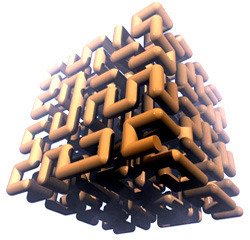Hilbert Space
 In the essay on Parallel Universes, we described what is called a Level 3 multiverse (ML3). An ML3 is one in which all possible outcomes of every decision, every cause, every interaction permitted by quantum mechanics already exists simultaneously in separate universes. For example, if you role a die, you will get one of six possible outcomes. In any one universe, only one outcome is possible, but in an ML3, all six outcomes occur at once, just in separate universes. Being trapped in our universe, we can see only the one outcome, but if we were somehow able to transcend our universe and observe all the universes in an ML3 at once, we would see all six outcomes at the same time.
In the essay on Parallel Universes, we described what is called a Level 3 multiverse (ML3). An ML3 is one in which all possible outcomes of every decision, every cause, every interaction permitted by quantum mechanics already exists simultaneously in separate universes. For example, if you role a die, you will get one of six possible outcomes. In any one universe, only one outcome is possible, but in an ML3, all six outcomes occur at once, just in separate universes. Being trapped in our universe, we can see only the one outcome, but if we were somehow able to transcend our universe and observe all the universes in an ML3 at once, we would see all six outcomes at the same time.The problem with an ML3 is that it really tells us nothing new. That is, an ML3 is really no different from a Level 1 (ML1) or a Level 2 multiverse (ML2). For example, a classical ML1 occurs when a Big Bang creates an infinite number of Hubble volumes and randomly sets the initial arrangements of their particles. A quantum ML1, however, starts off with just one Hubble volume, that then rapidly splits into an infinite number of branching volumes, each with its own set of probable outcomes. Yet the result is exactly the same in both cases: an infinite number of universes with an infinite variety of timelines. Put another way, the distribution of outcomes on different quantum branches in one Hubble volume is identical to the distribution of outcomes in multiple Hubble volumes within a single quantum branch.
So the result of adding an ML3 to a level one is to simply compound to infinity the number of possible parallel Hubble volumes, most of which will be identical to each other since each can only hold a finite number of particles arranged in a finite number of combinations. And the same result will occur at progressively higher levels as well. If through symmetry breaking an ML2 can create an infinite number of ML1s, each with its own cosmological properties, it can also create one that splits off into an infinite number of quantum branches. This phenomenon is known in statistical mechanics as the principle of ergodicity.
Read the rest of the article.
Published on December 17, 2013 04:02
•
Tags:
medb-herenn, world-building
No comments have been added yet.
Songs of the Seanchaí
Musings on my stories, the background of my stories, writing, and the world in general.
- Kevin L. O'Brien's profile
- 23 followers



